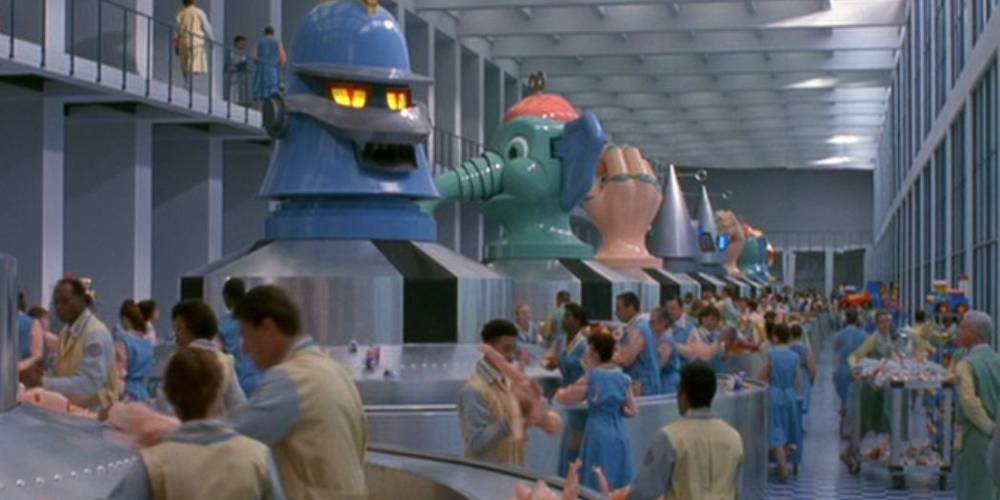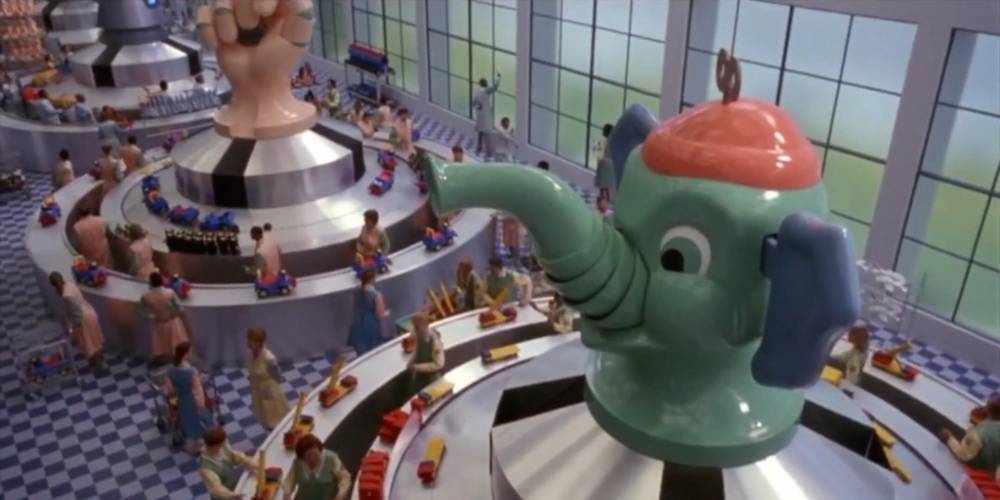Read also:
How to Watch FX Live Without CableHow To Watch AMC Without CableHow to Watch ABC Without CableHow to Watch Paramount Network Without CableBarry Levinson’s notorious passion project is a feast for the eyes that never quite figures out its tone.
A project that director/co-writer Barry Levinson had been working on for over a decade before it emerged in theaters in 1992—at one point, it had been planned as his directorial debut before he turned to Diner (1982) instead—Toys offered viewers a mélange of holiday sentiment, strident anti-war satire and the sometimes-unholy combination of schmaltz and schtick that marked the typical Robin Williams performance of the time, all produced on a budget high enough to outstrip the GNP of actual countries. There’s no reason on Earth to think that such a bizarre combination would have worked, and Toys’ eventual critical and commercial failure would seemingly confirm that it didn’t. And yet, while I concede that the film as a whole is a mess—it is an undeniably intriguing mess with just enough moments of genuine brilliance to help get through the rougher and clumsier passages, of which there are more than a few.
As the film opens, the staff of Zevo Toys, an elaborate toy factory that suggests what Willy Wonka’s workplace might have looked like before he decided to simplify, are staging their end-of-the-year Christmas pageant. At the same time, the benevolent owner Kenneth Zevo (Donald O’Connor), summons his estranged brother, Lt. Gen. Leland Zevo (Michael Gambon), for a talk. Kenneth is dying and fearing that neither his son, Leslie (Williams), nor daughter Alsatia (Joan Cusack), have what it takes to successfully run the company despite their evident love of toy making. Instead, Kenneth wants Leland to take over, assuming that by the time he chooses to retire, Leslie will finally be ready to take over. Before Leland can muster any objections, Kenneth’s heart gives out—and we learn that he had attached his pacemaker to the beanie hat that he wears. Why? “It’s whimsical,” Kenneth remarks before dropping dead, a moment many took to be unexpectedly prophetic, considering Toys’ eventual fate.

A military man, Leland has zero interest in running a toy factory and essentially cedes control of the day-to-day operations to Leslie and Alsatia; however, when he gets a load of the video games and war toys manufactured by other companies (though not by Zevo), he begins to contemplate the idea of creating toy-sized military armaments that could be produced far more cheaply than human-scale gear and which could be controlled remotely through video game-like interfaces. When military leaders dismiss his ideas as nonsense, Leland, aided by his son Patrick (L.L. Cool J), himself a soldier specializing in security and covert affairs, decides to do it on his own, first asking Leslie for a small area of the factory in which to work on his own thing and then expanding it wildly, displacing other departments and their workers as a result.
At first, the trusting Leslie is happy to let his uncle do his thing. But as Leland seizes more and more space and resources for his top-secret project and a sense of paranoia begins to hover over the once-happy factory, Leslie begins to suspect something is wrong. When he finally realizes what Leland is up to, he, Alsatia, Patrick, and Gwen (Robin Wright), a Zevo worker that Leslie is sweet on, decide that enough is enough. They sneak into the factory one night and end Leland’s takeover—leading to an over-the-top final battle in which Leland sets his array of hi-tech creations against Leslie’s army of gentler Zevo toys pressed into service to save the day.
After a while, the film feels like an inspired sketch idea stretched well beyond its breaking point.
After years of struggling to get the film made, Levinson finally found himself in the position where he could more or less get anything he wanted following a string of critical and commercial hits, including Tin Men (1986), Good Morning, Vietnam (1987), the Oscar-winning Rain Man (1988) and Avalon (1990) and elected to bring Toys to life at last. However, the elements that probably gave studio executives pause would seem to be there. Toys’ chief flaw is that Levinson never quite figures out the tone he wants, seesawing between sentiment and dark comedy without ever figuring out how to balance them. This is especially evident during the climactic battle—in which Leslie and Leland lead their troops into action, and viewers are presumably meant to first laugh at the mayhem and then be subsequently touched and horrified as the mechanized horror unfolds. Unfortunately, since Levinson and Valerie Curtin’s screenplay largely fails to establish any real dramatic or emotional stakes, we are left with a seemingly endless sequence of expensive doo-dads smashing into each other. After a while, the film feels like an inspired sketch idea stretched well beyond its breaking point.
Toys’ unfocused nature extends to its performances. As one of the many manic man-children that he would play throughout his career, Leslie allows Williams to indulge in his usual bag of tricks: riffing and scatting to his heart’s content, pausing only to deliver the occasional sentimental moment with the subtlety of a telethon host who wants to get serious for a moment. In his first significant role since his breakthrough in The Cook, the Thief, His Wife and Her Lover (1989), Gambon is a little better but never quite finds the right tone, at times too blustery and others too silly. As Leslie’s love interest, Wright is stuck with an ill-defined role that offers her little to do other than warmly beam at Leslie’s antics. Except for the delightful cameo from O’Connor (in what would be his final film), the best performance comes from Cusack, though one has to watch the entirety of Toys to understand why this is.

Despite these and other flaws, I still have a stubborn fondness for Toys’ goofball glory. For starters, it is a stunner visually—with an evidently unlimited budget and a style that pays homage throughout to the art of Rene Magritte, Modernism, and Dadaism, legendary production designer Fernando Scarfotti creates a look so striking and memorable that one could turn off the soundtrack and just revel in the eye-popping treats. While big set pieces like the climactic battle don’t quite land, several smaller jokes throughout earn some nice laughs—I’m especially fond of a bit where Leslie demonstrates an all-too-literal smoking jacket. The offbeat opening sequence juxtaposing the meeting of the brothers with the incredibly elaborate holiday pageant—especially its deployment of “The Closing of the Year,” a song featuring the vocals of former Revolution members Wendy & Lisa that is lovely enough that it might have gone on to be a holiday perennial if the film had not bombed so badly—is similarly striking.
For all of Toys’ messiness and clumsiness, it has a weirdo charm that one rarely sees in films of this magnitude. It’s a charm that has endured over the three decades since its original release. Toys‘ may ultimately be only a movie of moments but the best of those moments are so glorious to behold that they will stick in the minds of those who see them for a long time afterward.